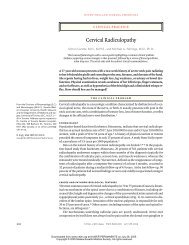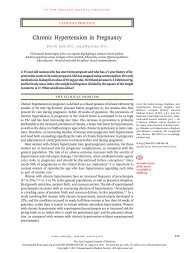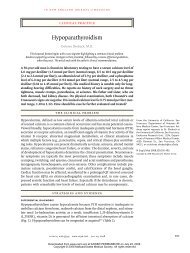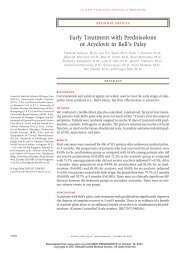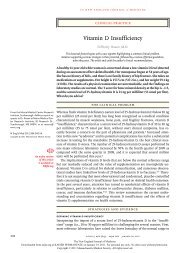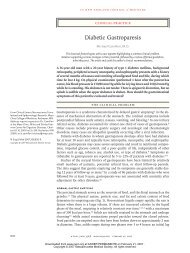Contrast-induced nephropathy: How it develops, how to prevent it
Contrast-induced nephropathy: How it develops, how to prevent it
Contrast-induced nephropathy: How it develops, how to prevent it
You also want an ePaper? Increase the reach of your titles
YUMPU automatically turns print PDFs into web optimized ePapers that Google loves.
CONTRAST-INDUCED NEPHROPATHY<br />
RUDNICK AND COLLEAGUES<br />
vide the necessary clinical information. In many<br />
cases, ultrasonography, nuclear medicine, magnetic<br />
resonance, and unenhanced computed<br />
<strong>to</strong>mography can provide sufficient data w<strong>it</strong>hout<br />
exposing the patient <strong>to</strong> iodinated contrast media<br />
and the risk of contrast-<strong>induced</strong> <strong>nephropathy</strong>.<br />
When exposure <strong>to</strong> iodinated contrast<br />
media is unavoidable, we recommend the following<br />
approach.<br />
• Nonsteroidal anti-inflamma<strong>to</strong>ry drugs<br />
should be discontinued before contrast exposure.<br />
• Patients should receive hydration w<strong>it</strong>h<br />
intravenous normal saline starting 2 <strong>to</strong> 4 hours<br />
before receiving the contrast, during the radiographic<br />
procedure, and continuing 4 <strong>to</strong> 6 hours<br />
afterward. The duration of the saline infusion<br />
should be longer w<strong>it</strong>h more severe chronic kidney<br />
disease or if underlying diabetic <strong>nephropathy</strong><br />
is present.<br />
• The radiologist or cardiologist should use<br />
the smallest volume of contrast needed <strong>to</strong><br />
obtain the cr<strong>it</strong>ical imaging.<br />
• Based on currently available data, there<br />
may be an advantage in using iso-osmolar contrast<br />
media.<br />
• Hypotension in the peri-imaging period<br />
should be avoided if possible.<br />
• N-acetylcysteine and bicarbonate hydration<br />
can be used since they are safe and inexpensive,<br />
although their use is somewhat controversial.<br />
• Serum creatinine should be measured<br />
approximately 48 hours after contrast exposure<br />
<strong>to</strong> determine if contrast-<strong>induced</strong> <strong>nephropathy</strong><br />
has occurred.<br />
■ REFERENCES<br />
1. Hou SH, Bushinsky DA, Wish JB, Cohen JJ, Harring<strong>to</strong>n JT. Hosp<strong>it</strong>alacquired<br />
renal insufficiency: a prospective study. Am J Med 1983;<br />
74:243–248.<br />
2. American Heart Association. Heart Disease and Stroke Statistics—<br />
2003 Update, pp 38–39.<br />
3. McClennan BL. Low-osmolal<strong>it</strong>y contrast media: premises and promises.<br />
Radiology 1987; 162:1–8.<br />
4. Levy EM, Viscoli CM, Horw<strong>it</strong>z RI. The effect of acute renal failure on<br />
mortal<strong>it</strong>y. A cohort analysis. JAMA 1996; 275:1489–1494.<br />
5. McCullough PA, Wolyn R, Rocher LL, Levin RN, O’Neill WW. Acute<br />
renal failure after coronary intervention: incidence, risk fac<strong>to</strong>rs, and<br />
relationship <strong>to</strong> mortal<strong>it</strong>y. Am J Med 1997; 103:368–375.<br />
6. Szczech LA, Reddan DN, Owen WF Jr, et al. Differential survival after<br />
coronary revascularization procedures among patients w<strong>it</strong>h renal<br />
insufficiency. Kidney Int 2001; 60:292–299.<br />
7. Reinecke H, Trey T, Matzkies F, Fobker M, Bre<strong>it</strong>hardt G, Schaefer RM.<br />
Grade of chronic renal failure, and acute and long-term outcome<br />
after percutaneous coronary interventions. Kidney Int 2003;<br />
63:696–701.<br />
8. Rudnick MR, Berns JS, Cohen RM, Goldfarb S. <strong>Contrast</strong> media-associated<br />
nephro<strong>to</strong>xic<strong>it</strong>y. Semin Nephrol 1997; 17:15–26.<br />
9. Berns AS. Nephro<strong>to</strong>xic<strong>it</strong>y of contrast media. Kidney Int 1989;<br />
36:730–740.<br />
10. Rudnick MR, Berns JS, Cohen RM, Goldfarb S. Nephro<strong>to</strong>xic risks of<br />
renal angiography: contrast media-associated nephro<strong>to</strong>xic<strong>it</strong>y and<br />
atheroembolism—a cr<strong>it</strong>ical review. Am J Kidney Dis 1994;<br />
24:713–727.<br />
11. Rudnick MR, Goldfarb S, Wexler L, et al. The Iohexol Cooperative<br />
Study. Nephro<strong>to</strong>xic<strong>it</strong>y of ionic and nonionic contrast media in 1196<br />
patients: a randomized trial. Kidney Int 1995; 47:254–261.<br />
12. Manske CL, Sprafka JM, Strony JT, Wang Y. <strong>Contrast</strong> <strong>nephropathy</strong> in<br />
azotemic diabetic patients undergoing coronary angiography. Am J<br />
Med 1990; 89:615–620.<br />
13. Cigarroa RG, Lange RA, Williams RH, Hillis LD. Dosing of contrast<br />
material <strong>to</strong> <strong>prevent</strong> contrast <strong>nephropathy</strong> in patients w<strong>it</strong>h renal disease.<br />
Am J Med 1989; 86(6 Pt 1):649–652.<br />
14. Barrett BJ, Parfrey PS, Vavasour HM, et al. <strong>Contrast</strong> <strong>nephropathy</strong> in<br />
patients w<strong>it</strong>h impaired renal function: high versus low osmolar<br />
media. Kidney Int 1992; 41:1274–1279.<br />
15. McCarthy CS, Becker JA. Multiple myeloma and contrast media.<br />
Radiology 1992; 183:519–522.<br />
16. Katzberg RW, Morris TW, Burgener FA, Kamm DE, Fischer HW. Renal<br />
renin and hemodynamic responses <strong>to</strong> selective renal artery catheterization<br />
and angiography. Invest Radiol 1977; 12:381–388.<br />
17. Heyman SN, Brezis M, Reubinoff CA, et al. Acute renal failure w<strong>it</strong>h<br />
selective medullary injury in the rat. J Clin Invest 1988; 82:401–412.<br />
18. Heyman SN, Brezis M, Epstein FH, Spokes K, Silva P, Rosen S. Early<br />
renal medullary hypoxic injury from radiocontrast and<br />
indomethacin. Kidney Int 1991; 40:632–642.<br />
19. Heyman SN, Rosen S, Brezis M. Radiocontrast <strong>nephropathy</strong>: a paradigm<br />
for the synergism between <strong>to</strong>xic and hypoxic insults in the kidney.<br />
Exp Nephrol 1994; 2:153–157.<br />
20. Brezis M, Rosen S. Hypoxia of the renal medulla—<strong>it</strong>s implications for<br />
disease. N Engl J Med 1995; 332:647–655.<br />
21. Wang A, Holcslaw T, Bashore TM, et al. Exacerbation of radiocontrast<br />
nephro<strong>to</strong>xic<strong>it</strong>y by endothelin recep<strong>to</strong>r antagonism. Kidney Int<br />
2000; 57:1675–1680.<br />
22. Pflueger A, Larson TS, Nath KA, King BF, Gross JM, Knox FG. Role of<br />
adenosine in contrast media-<strong>induced</strong> acute renal failure in diabetes<br />
mell<strong>it</strong>us. Mayo Clin Proc 2000; 75:1275–1283.<br />
23. Barrett BJ, Carlisle EJ. Meta-analysis of the relative nephro<strong>to</strong>xic<strong>it</strong>y of<br />
high- and low-osmolal<strong>it</strong>y iodinated contrast media. Radiology 1993;<br />
188:171–178.<br />
24. Aspelin P, Aubry P, Fransson SG, Strasser R, Willenbrock R, Berg KJ;<br />
Nephro<strong>to</strong>xic<strong>it</strong>y in High-Risk Patients Study of Iso-Osmolar and Low-<br />
Osmolar Non-Ionic <strong>Contrast</strong> Media Study Investiga<strong>to</strong>rs. Nephro<strong>to</strong>xic<br />
effects in high-risk patients undergoing angiography. N Engl J Med<br />
2003; 348:491–499.<br />
25. Talner LB, Rushmer HN, Coel MN. The effect of renal artery injection<br />
of contrast material on urinary enzyme excretion. Invest Radiol 1972;<br />
7:311–322.<br />
26. Liss P, Nygren A, Erikson U, Ulfendahl HR. Injection of low and isoosmolar<br />
contrast medium decreases oxygen tension in the renal<br />
medulla. Kidney Int 1998; 53:698–702.<br />
27. Lancelot E, Idee JM, Lacledere C, Santus R, Corot C. Effects of two<br />
dimeric iodinated contrast media on renal medullary blood perfusion<br />
and oxygenation in dogs. Invest Radiol 2002; 37:368–375.<br />
28. Bakris GL, Lass N, Gaber AO, Jones JD, Burnett JC Jr. Radiocontrast<br />
medium-<strong>induced</strong> declines in renal function: a role for oxygen free<br />
radicals. Am J Physiol 1990;258(1 Pt 2):F111–F120.<br />
29. Messana JM, Cieslinski DA, Nguyen VD, Humes HD. Comparison of<br />
the <strong>to</strong>xic<strong>it</strong>y of the radiocontrast agents, iopamidol and diatrizoate,<br />
<strong>to</strong> rabb<strong>it</strong> renal proximal tubule cells in v<strong>it</strong>ro. J Pharmacol Exp Ther<br />
1988; 244:1139–1144.<br />
86 CLEVELAND CLINIC JOURNAL OF MEDICINE VOLUME 73 • NUMBER 1 JANUARY 2006






